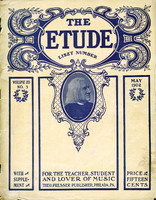From the German.
BY WALDEMAR MALMENE.
As A solid foundation is of the utmost importance to a building without which the superstructure would be a failure, so are also the first years of musical instruction to children of tender years. The choice of suitable compositions requires much care; not only should they correspond with the pupil’s grade of proficiency, but they must also be attractive from a musical standpoint.
The purely technical, or external, part of instruction should not form the chief consideration, for that is merely mechanical, and can be acquired by almost anyone who has sufficient perseverance. An expressive tasteful style of playing, no matter how simple the composition may be, should receive the utmost attention and be insisted upon. That so many printed methods are deficient in this respect is easily accounted for; they are compiled to meet the requirements of the generality of learners, while the peculiarities of character, mind, conception, and emotion of each pupil must be taken in consideration next to musical talent.
Piano-instruction books in general are injurious when they are in the hands of teachers whose incapacity forces them to follow blindly the course dictated by the book no matter how great the mental diversity of pupils may be.
It behooves the teacher to take the following points in consideration, viz.:
First.—Select such compositions and pieces as are not too long, and in which an easy, natural, flowing melody, commonly called singable, predominates.
Second.—Harmony and rhythm should not be too complicated and intricate, even if arranged in a simplified form; they are not suited to the musical taste of a child, and will not further his progress.
Third.—Pieces in which dissonances preponderate, and in which the melodies are manufactured according to the dry rules of counterpoint, can never attract a child.
Fourth.—Compositions of a so-called pathetic character are likewise not congenial to a child’s taste, nor could it be expected that he could interpret them with the necessary taste and feeling.
Hence it follows that for a child the music should be cheerful, lively, and graceful; these conditions are in harmony with a child’s natural temperament, and by it the best results will be obtained as regards progress and cultivation of taste.
A careful observer must have noticed that children like best short and interesting stories to read, in which words ot not more than two syllables are used and the meaning of which is within their capacity to understand. Such a course should also be adopted in music. A composition that fascinates will be cheerfully practiced; the progress will be in proportion and the flexibility of fingers will naturally follow. Mistakes in the selection are often the cause of dislike for music.
Musical childhood which has been nourished by healthy musical food will in after-years be the musical public whose patronage is of equal importance to both art and artist.



